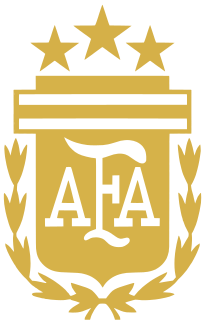
South America is a continent entirely in the Western Hemisphere and mostly in the Southern Hemisphere, with a relatively small portion in the Northern Hemisphere. It can also be described as a southern subcontinent of the Americas. The reference to South America instead of other regions has increased in the last decades due to changing geopolitical dynamics.

The Brazil national football team represents Brazil in men's international football and is administered by the Brazilian Football Confederation (CBF), the governing body for football in Brazil. They have been a member of FIFA since 1923 and a member of CONMEBOL since 1916.

The 1978 FIFA World Cup was the 11th edition of the FIFA World Cup, quadrennial international football world championship tournament among the men's senior national teams. It was held in Argentina between 1 and 25 June.

The Argentina national football team represents Argentina in men's international football and is administered by the Argentine Football Association, the governing body for football in Argentina. Argentina's home stadium is Estadio Monumental Antonio Vespucio Liberti in Buenos Aires.

The Paraguayan War, also known as the War of the Triple Alliance was a South American war fought from 1864 to 1870, between Paraguay and the Triple Alliance of Argentina, the Empire of Brazil, and Uruguay. It was the deadliest and bloodiest inter-state war in Latin America's history. It particularly devastated Paraguay, which suffered catastrophic losses in population and was forced to cede disputed territory to Argentina and Brazil.

The following outline is provided as an overview of and topical guide to South America.
The Brazil Olympic football team represents Brazil in international football competitions during Olympic Games and Pan American Games. The selection is limited to players under the age of 23, except three overage players. The team is controlled by the Brazilian Football Confederation (CBF).
Neopostega asymmetra is a moth of the family Opostegidae. It is known only from the type locality, in the Atlantic coastal forest in southern Brazil.
Neopostega distola is a moth of the family Opostegidae. It is known only from south-western Brazil and northern Costa Rica.
Pseudopostega tucumanae is a moth of the family Opostegidae. It is only known from the province of Tucuman, in northern Argentina at an elevation of 800 meters.
Pseudopostega monosperma is a moth of the family Opostegidae. It was described by Edward Meyrick in 1931. It is known from Bahia, Brazil.
Pseudopostega venticola is a moth of the family Opostegidae. It was described by Walsingham, Lord Thomas de Grey, in 1897. It is known from much of the Neotropical Region from southern Florida and Texas, through much of the West Indies and Central America to southern Brazil.
Pseudopostega acrodicra is a moth of the family Opostegidae. It was described by Donald R. Davis and Jonas R. Stonis, 2007. It is known from south-central Brazil.
Pseudopostega acuminata is a moth of the family Opostegidae. It was described by Donald R. Davis and Jonas R. Stonis, 2007. It is known from northern Argentina and north-western Venezuela.
Pseudopostega breviapicula is a moth of the family Opostegidae. It was described by Donald R. Davis and Jonas R. Stonis, 2007. It has a wide range in the Neotropical Region from Panama south to north-eastern and south-eastern Brazil and north-central Argentina.
Pseudopostega curtarama is a moth of the family Opostegidae. It was described by Donald R. Davis and Jonas R. Stonis, 2007. It is known from the provinces of Goias and Minas Gerais in southern Brazil.
Pseudopostega divaricata is a moth of the family Opostegidae. It was described by Donald R. Davis and Jonas R. Stonis, 2007. It is known from northern Argentina.
Pseudopostega lobata is a moth of the family Opostegidae. It was described by Donald R. Davis and Jonas R. Stonis, 2007. It is probably a common, widespread neotropical species, now reported in Central America from Belize to Costa Rica, with two records from northern Argentina.
Pseudopostega plicatella is a moth of the family Opostegidae. It was described by Donald R. Davis and Jonas R. Stonis, 2007. It is known from Pará in north-eastern Brazil and east-central Ecuador.
Pseudopostega suffuscula is a moth of the family Opostegidae. It was described by Donald R. Davis and Jonas R. Stonis, 2007. It is known from the provinces of Salta and Tucumán in northern Argentina.





